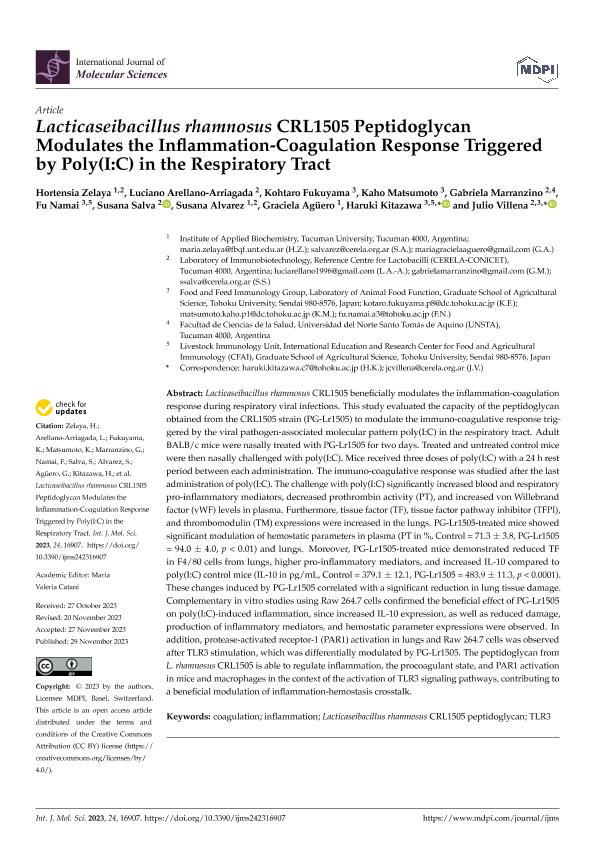Artículo
Lacticaseibacillus rhamnosus CRL1505 Peptidoglycan Modulates the Inflammation-Coagulation Response Triggered by Poly(I:C) in the Respiratory Tract
Zelaya, María Hortensia del Rosario ; Arellano Arriagada, Luciano; Fukuyama, Kohtaro; Matsumoto, Kaho; Marranzino, Gabriela
; Arellano Arriagada, Luciano; Fukuyama, Kohtaro; Matsumoto, Kaho; Marranzino, Gabriela ; Namai, Fu; Salva, Maria Susana
; Namai, Fu; Salva, Maria Susana ; Alvarez, Susana; Agüero, Graciela; Kitazawa, Haruki; Villena, Julio Cesar
; Alvarez, Susana; Agüero, Graciela; Kitazawa, Haruki; Villena, Julio Cesar
 ; Arellano Arriagada, Luciano; Fukuyama, Kohtaro; Matsumoto, Kaho; Marranzino, Gabriela
; Arellano Arriagada, Luciano; Fukuyama, Kohtaro; Matsumoto, Kaho; Marranzino, Gabriela ; Namai, Fu; Salva, Maria Susana
; Namai, Fu; Salva, Maria Susana ; Alvarez, Susana; Agüero, Graciela; Kitazawa, Haruki; Villena, Julio Cesar
; Alvarez, Susana; Agüero, Graciela; Kitazawa, Haruki; Villena, Julio Cesar
Fecha de publicación:
11/2023
Editorial:
Molecular Diversity Preservation International
Revista:
International Journal of Molecular Sciences
ISSN:
1422-0067
Idioma:
Inglés
Tipo de recurso:
Artículo publicado
Clasificación temática:
Resumen
Lacticaseibacillus rhamnosus CRL1505 beneficially modulates the inflammation-coagulation response during respiratory viral infections. This study evaluated the capacity of the peptidoglycan obtained from the CRL1505 strain (PG-Lr1505) to modulate the immuno-coagulative response triggered by the viral pathogen-associated molecular pattern poly(I:C) in the respiratory tract. Adult BALB/c mice were nasally treated with PG-Lr1505 for two days. Treated and untreated control mice were then nasally challenged with poly(I:C). Mice received three doses of poly(I:C) with a 24 h rest period between each administration. The immuno-coagulative response was studied after the last administration of poly(I:C). The challenge with poly(I:C) significantly increased blood and respiratory pro-inflammatory mediators, decreased prothrombin activity (PT), and increased von Willebrand factor (vWF) levels in plasma. Furthermore, tissue factor (TF), tissue factor pathway inhibitor (TFPI), and thrombomodulin (TM) expressions were increased in the lungs. PG-Lr1505-treated mice showed significant modulation of hemostatic parameters in plasma (PT in %, Control = 71.3 ± 3.8, PG-Lr1505 = 94.0 ± 4.0, p < 0.01) and lungs. Moreover, PG-Lr1505-treated mice demonstrated reduced TF in F4/80 cells from lungs, higher pro-inflammatory mediators, and increased IL-10 compared to poly(I:C) control mice (IL-10 in pg/mL, Control = 379.1 ± 12.1, PG-Lr1505 = 483.9 ± 11.3, p < 0.0001). These changes induced by PG-Lr1505 correlated with a significant reduction in lung tissue damage. Complementary in vitro studies using Raw 264.7 cells confirmed the beneficial effect of PG-Lr1505 on poly(I:C)-induced inflammation, since increased IL-10 expression, as well as reduced damage, production of inflammatory mediators, and hemostatic parameter expressions were observed. In addition, protease-activated receptor-1 (PAR1) activation in lungs and Raw 264.7 cells was observed after TLR3 stimulation, which was differentially modulated by PG-Lr1505. The peptidoglycan from L. rhamnosus CRL1505 is able to regulate inflammation, the procoagulant state, and PAR1 activation in mice and macrophages in the context of the activation of TLR3 signaling pathways, contributing to a beneficial modulation of inflammation-hemostasis crosstalk.
Archivos asociados
Licencia
Identificadores
Colecciones
Articulos(CCT - NOA SUR)
Articulos de CTRO.CIENTIFICO TECNOL.CONICET - NOA SUR
Articulos de CTRO.CIENTIFICO TECNOL.CONICET - NOA SUR
Articulos(CERELA)
Articulos de CENTRO DE REFERENCIA PARA LACTOBACILOS (I)
Articulos de CENTRO DE REFERENCIA PARA LACTOBACILOS (I)
Citación
Zelaya, María Hortensia del Rosario; Arellano Arriagada, Luciano; Fukuyama, Kohtaro; Matsumoto, Kaho; Marranzino, Gabriela; et al.; Lacticaseibacillus rhamnosus CRL1505 Peptidoglycan Modulates the Inflammation-Coagulation Response Triggered by Poly(I:C) in the Respiratory Tract; Molecular Diversity Preservation International; International Journal of Molecular Sciences; 24; 23; 11-2023; 1-18
Compartir
Altmétricas



